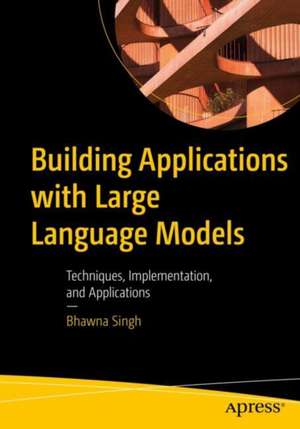Building Applications with Large Language Models: Techniques, Implementation, and Applications
Autor Bhawna Singhen Limba Engleză Paperback – 21 dec 2024
The book takes you through the complexities involved in creating and deploying applications based on LLMs, providing you with an in-depth understanding of the model architecture. You will explore techniques such as fine-tuning, prompt engineering, and retrieval augmented generation (RAG). The book also addresses different ways to evaluate LLM outputs and discusses the benefits and limitations of large models. The book focuses on the tools, techniques, and methods essential for developing Large Language Models. It includes hands-on examples and tips to guide you in building applications using the latest technology in Natural Language Processing (NLP). It presents a roadmap to assist you in navigating challenges related to constructing and deploying LLM-based applications.
By the end of the book, you will understand LLMs and build applications with use cases that align with emerging business needs and address various problems in the realm of language processing.
What You Will Learn
- Be able to answer the question: What are Large Language Models?
- Understand techniques such as prompt engineering, fine-tuning, RAG, and vector databases
- Know the best practices for effective implementation
- Know the metrics and frameworks essential for evaluating the performance of Large Language Models
Who This Book Is For
An essential resource for AI-ML developers and enthusiasts eager to acquire practical, hands-on experience in this domain; also applies to individuals seeking a technical understanding of Large Language Models (LLMs) and those aiming to build applications using LLMs
Preț: 283.73 lei
Preț vechi: 354.66 lei
-20% Nou
Puncte Express: 426
Preț estimativ în valută:
54.29€ • 59.16$ • 45.75£
54.29€ • 59.16$ • 45.75£
Carte disponibilă
Livrare economică 02-16 aprilie
Preluare comenzi: 021 569.72.76
Specificații
ISBN-13: 9798868805684
Pagini: 200
Ilustrații: Approx. 200 p.
Dimensiuni: 155 x 235 mm
Greutate: 0.52 kg
Ediția:First Edition
Editura: Apress
Colecția Apress
Locul publicării:Berkeley, CA, United States
Pagini: 200
Ilustrații: Approx. 200 p.
Dimensiuni: 155 x 235 mm
Greutate: 0.52 kg
Ediția:First Edition
Editura: Apress
Colecția Apress
Locul publicării:Berkeley, CA, United States
Cuprins
Chapter 1: Introduction to Large Language Models.- Chapter 2: Understanding Foundation Models.- Chapter 3: Adapt with Fine-tuning.- Chapter 4: The Magic of Prompt Engineering.- Chapter 5: Stop Hallucination with RAG.- Chapter 6: Evaluation of LLM.- Chapter 7: Tools and Frameworks for Development.- Chapter 8: Run in Production.-Chapter 9: The Ethical Dilemma.- Chapter 10: Future of AI.
Notă biografică
Bhawna Singh, a Data Scientist at CeADAR (UCD), holds both a bachelor and master degree in computer science. During her master’s program, she conducted research focused on identifying gender bias in Energy Policy data across the European Union. With prior experience as a Data Scientist at Brightflag in Ireland and a Machine Learning Engineer at AISmartz in India, Bhawna brings a wealth of expertise from both industry and academia. Her current research interests center on exploring diverse applications of Large Language Models. Over the course of her career, Bhawna has built models on extensive datasets, contributing to the development of intelligent systems addressing challenges such as customer churn, propensity prediction, sales forecasting, recommendation engines, customer segmentation, pdf validation, and more. She is dedicated to creating AI systems that are accessible to everyone, promoting inclusivity regardless of race, gender, social status, or language.
Textul de pe ultima copertă
This book delves into a broad spectrum of topics, covering the foundational aspects of Large Language Models (LLMs) such as PaLM, LLaMA, BERT, and GPT, among others.
The book takes you through the complexities involved in creating and deploying applications based on LLMs, providing you with an in-depth understanding of the model architecture. You will explore techniques such as fine-tuning, prompt engineering, and retrieval augmented generation (RAG). The book also addresses different ways to evaluate LLM outputs and discusses the benefits and limitations of large models. The book focuses on the tools, techniques, and methods essential for developing Large Language Models. It includes hands-on examples and tips to guide you in building applications using the latest technology in Natural Language Processing (NLP). It presents a roadmap to assist you in navigating challenges related to constructing and deploying LLM-based applications.
By the end of the book, you will understand LLMs and build applications with use cases that align with emerging business needs and address various problems in the realm of language processing.
What You Will Learn
The book takes you through the complexities involved in creating and deploying applications based on LLMs, providing you with an in-depth understanding of the model architecture. You will explore techniques such as fine-tuning, prompt engineering, and retrieval augmented generation (RAG). The book also addresses different ways to evaluate LLM outputs and discusses the benefits and limitations of large models. The book focuses on the tools, techniques, and methods essential for developing Large Language Models. It includes hands-on examples and tips to guide you in building applications using the latest technology in Natural Language Processing (NLP). It presents a roadmap to assist you in navigating challenges related to constructing and deploying LLM-based applications.
By the end of the book, you will understand LLMs and build applications with use cases that align with emerging business needs and address various problems in the realm of language processing.
What You Will Learn
- Be able to answer the question: What are Large Language Models?
- Understand techniques such as prompt engineering, fine-tuning, RAG, and vector databases
- Know the best practices for effective implementation
- Know the metrics and frameworks essential for evaluating the performance of Large Language Models
Caracteristici
Focuses on foundational models, architecture, and different model types of LLM’s Covers techniques for customizing LLMs to specific tasks with prompt engineering, and retrieval augmented generation Explains deploying LLMs in production, and exploring ethical dilemmas about privacy, security, and fairness issues
